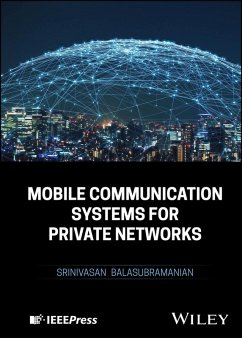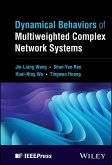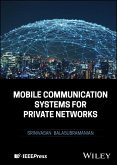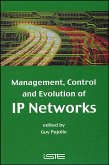Srinivasan Balasubramanian
Mobile Communication Systems for Private Networks (eBook, ePUB)
107,99 €
107,99 €
inkl. MwSt.
Sofort per Download lieferbar

0 °P sammeln
107,99 €
Als Download kaufen

107,99 €
inkl. MwSt.
Sofort per Download lieferbar

0 °P sammeln
Jetzt verschenken
Alle Infos zum eBook verschenken
107,99 €
inkl. MwSt.
Sofort per Download lieferbar
Alle Infos zum eBook verschenken

0 °P sammeln
Srinivasan Balasubramanian
Mobile Communication Systems for Private Networks (eBook, ePUB)
- Format: ePub
- Merkliste
- Auf die Merkliste
- Bewerten Bewerten
- Teilen
- Produkt teilen
- Produkterinnerung
- Produkterinnerung

Bitte loggen Sie sich zunächst in Ihr Kundenkonto ein oder registrieren Sie sich bei
bücher.de, um das eBook-Abo tolino select nutzen zu können.
Hier können Sie sich einloggen
Hier können Sie sich einloggen
Sie sind bereits eingeloggt. Klicken Sie auf 2. tolino select Abo, um fortzufahren.

Bitte loggen Sie sich zunächst in Ihr Kundenkonto ein oder registrieren Sie sich bei bücher.de, um das eBook-Abo tolino select nutzen zu können.
Understand the role of network communications in the private sector with this timely guide
4G and 5G wireless communication technologies have come to dominate network communications in recent years, and their expansion is only continuing. Most existing treatments of this key subject, however, deal with large-scale public networks, not the private networks whose deployment constitutes one of the major current growth areas in wireless technology. There is an urgent need for a guide to network communication deployment specifically for private enterprises.
Mobile Communication Systems for…mehr
- Geräte: eReader
- mit Kopierschutz
- eBook Hilfe
- Größe: 31.97MB
Andere Kunden interessierten sich auch für
![Dynamical Behaviors of Multiweighted Complex Network Systems (eBook, ePUB) Dynamical Behaviors of Multiweighted Complex Network Systems (eBook, ePUB)]() Jin-Liang WangDynamical Behaviors of Multiweighted Complex Network Systems (eBook, ePUB)103,99 €
Jin-Liang WangDynamical Behaviors of Multiweighted Complex Network Systems (eBook, ePUB)103,99 €![Hacking VoIP (eBook, ePUB) Hacking VoIP (eBook, ePUB)]() Himanshu DwivediHacking VoIP (eBook, ePUB)20,95 €
Himanshu DwivediHacking VoIP (eBook, ePUB)20,95 €![A Volterra Approach to Digital Predistortion (eBook, ePUB) A Volterra Approach to Digital Predistortion (eBook, ePUB)]() Carlos Crespo-CadenasA Volterra Approach to Digital Predistortion (eBook, ePUB)108,99 €
Carlos Crespo-CadenasA Volterra Approach to Digital Predistortion (eBook, ePUB)108,99 €![Mobile Communication Systems for Private Networks (eBook, PDF) Mobile Communication Systems for Private Networks (eBook, PDF)]() Srinivasan BalasubramanianMobile Communication Systems for Private Networks (eBook, PDF)107,99 €
Srinivasan BalasubramanianMobile Communication Systems for Private Networks (eBook, PDF)107,99 €![Juniper QFX10000 Series (eBook, ePUB) Juniper QFX10000 Series (eBook, ePUB)]() Douglas Richard Hanks Jr.Juniper QFX10000 Series (eBook, ePUB)31,95 €
Douglas Richard Hanks Jr.Juniper QFX10000 Series (eBook, ePUB)31,95 €![Management, Control and Evolution of IP Networks (eBook, ePUB) Management, Control and Evolution of IP Networks (eBook, ePUB)]() Management, Control and Evolution of IP Networks (eBook, ePUB)318,99 €
Management, Control and Evolution of IP Networks (eBook, ePUB)318,99 €![VoIP Hacks (eBook, ePUB) VoIP Hacks (eBook, ePUB)]() Theodore WallingfordVoIP Hacks (eBook, ePUB)13,95 €
Theodore WallingfordVoIP Hacks (eBook, ePUB)13,95 €-
-
-
Understand the role of network communications in the private sector with this timely guide
4G and 5G wireless communication technologies have come to dominate network communications in recent years, and their expansion is only continuing. Most existing treatments of this key subject, however, deal with large-scale public networks, not the private networks whose deployment constitutes one of the major current growth areas in wireless technology. There is an urgent need for a guide to network communication deployment specifically for private enterprises.
Mobile Communication Systems for Private Networks meets this need with a cutting-edge but accessible overview of the subject. Alerting to the specific needs of the private enterprise network and the disruption potential of cellular network operations, it surveys the early lessons of the global private network rollout for the benefit of future operations. With an eye towards future challenges and developments, this essential text is suitable for professionals in the network communications industry and its partners.
Readers will also find:
Mobile Communication Systems for Private Networks is an ideal reference for end user devices, network operators, chip manufacturers, researchers, and all other professionals and stakeholders with roles in the information and operational technology industries.
4G and 5G wireless communication technologies have come to dominate network communications in recent years, and their expansion is only continuing. Most existing treatments of this key subject, however, deal with large-scale public networks, not the private networks whose deployment constitutes one of the major current growth areas in wireless technology. There is an urgent need for a guide to network communication deployment specifically for private enterprises.
Mobile Communication Systems for Private Networks meets this need with a cutting-edge but accessible overview of the subject. Alerting to the specific needs of the private enterprise network and the disruption potential of cellular network operations, it surveys the early lessons of the global private network rollout for the benefit of future operations. With an eye towards future challenges and developments, this essential text is suitable for professionals in the network communications industry and its partners.
Readers will also find:
- The background required to design, deploy, and manage enterprise private networks driven by 4G and 5G technologies
- Detailed discussion of topics including fundamentals of 4G & 5G, standards bodies and their role in defining specifications for private networks, layer 3 concepts, IP connectivity, and many more
- Solutions to the urgent need for ubiquitous 5-bar connectivity both indoor and outdoor
Mobile Communication Systems for Private Networks is an ideal reference for end user devices, network operators, chip manufacturers, researchers, and all other professionals and stakeholders with roles in the information and operational technology industries.
Dieser Download kann aus rechtlichen Gründen nur mit Rechnungsadresse in D ausgeliefert werden.
Produktdetails
- Produktdetails
- Verlag: John Wiley & Sons
- Seitenzahl: 1178
- Erscheinungstermin: 3. Januar 2025
- Englisch
- ISBN-13: 9781394201792
- Artikelnr.: 72739012
- Verlag: John Wiley & Sons
- Seitenzahl: 1178
- Erscheinungstermin: 3. Januar 2025
- Englisch
- ISBN-13: 9781394201792
- Artikelnr.: 72739012
- Herstellerkennzeichnung Die Herstellerinformationen sind derzeit nicht verfügbar.
Srinivasan Balasubramanian is an industry expert in telecommunications, networking, and enterprise systems, with extensive experience across multiple generations of cellular technology, including both 4G and 5G. He has relationships across the network operations field, and his 532+ patents make him a proven innovator.
Preface xxi
Acknowledgments xxxv
Introduction xxvii
Part I Laying the Foundation 1
I.1 LTE Fundamentals 3
I.1.1 Introduction 3
I.1.2 LTE Network Architecture 4
I.1.3 LTE Identifiers 5
I.1.4 Broadcast Signals/Messages and Cell Selection 9
I.1.5 What Happens When a UE Is Switched On? 10
I.1.6 LTE Resource Grid 15
I.1.7 RACH Procedure 15
I.1.8 RRC Connection Setup 15
I.1.9 Non- access Stratum Procedures 15
I.1.10 DL Packet Transmission 27
I.1.11 UL Packet Transmission 33
I.1.12 Encryption 35
I.1.13 Channel Estimation 37
I.1.14 Layer 2 Protocols 38
I.1.15 Cell Reselection 47
I.1.16 Connected Mode Mobility 53
I.1.17 Timing Advance 55
I.1.18 Summary 58
Reference 59
Part I.2 NR Fundamentals 61
I.2.1 5G NR Fundamentals 63
I.2.1.1 5G NR Introduction 63
I.2.1.2 Channel Bandwidth 66
I.2.1.3 NR Network Architecture 69
I.2.1.4 RAN Evolution 74
I.2.1.5 Summary 92
References 92
I.2.2 NR Physical Layer 93
I.2.2.1 Introduction 93
I.2.2.2 Physical Channels and Reference Signals 93
I.2.2.3 NR UE Acquisition 97
I.2.2.4 Control Resource Set 100
I.2.2.5 NR UE Scheduling 105
I.2.2.6 NR PUCCH Operations 106
I.2.2.7 NR MIMO Operations 111
I.2.2.8 NR Power Control 112
I.2.2.9 Summary 114
Reference 114
I.2.3 Beamforming and Massive MIMO 115
I.2.3.1 Introduction 115
I.2.3.2 Beamforming - Spatial Diversity 116
I.2.3.3 Beam Management 119
I.2.3.4 Massive MIMO, Operation in UL and dl 119
I.2.3.5 Summary 126
Further Reading 127
I.2.4 NR Millimeter Wave 129
I.2.4.1 mmWave Introduction 129
I.2.4.2 Mitigative Techniques to Operate with mmWave 130
I.2.4.3 Summary 132
References 132
I.2.5 NR Unlicensed 135
I.2.5.1 Introduction 135
I.2.5.2 Techniques Introduced in 3GPP to Aid NR- U 137
I.2.5.3 Summary 143
References 143
I.2.6 NR Mobility 145
I.2.6.1 Introduction 145
I.2.6.2 Connected Mode Mobility - NSA Option 3 Family 152
I.2.6.3 Summary 153
References 153
I.2.7 NR Protocols 157
I.2.7.1 Introduction 157
I.2.7.2 NSA Option 3 Mode of Operation 158
I.2.7.3 5G NR RRC States: SA Option 2 159
I.2.7.4 PDCP Duplication 159
I.2.7.5 SDAP Layer 161
I.2.7.6 PDCP Functions 163
I.2.7.7 RLC Functions 163
I.2.7.8 MAC Layer 164
I.2.7.9 Summary 167
References 167
I.3 Standards 171
I.3.1 3gpp 171
I.3.2 WinnForum Specifications for Shared Spectrum Usage 172
I.3.3 OnGo Alliance 176
I.3.4 Small Cell Forum 178
I.3.5 GSMA 178
I.3.6 5G ACIA 182
I.3.7 O- RAN Alliance 183
I.3.8 National Spectrum Consortium 185
I.3.9 Summary 185
References 186
Part II Technological Framework 187
Part II.1 Radio Access Network Aspects 189
II.1.1 Global Private Spectrum Allocations 191
II.1.1.1 Introduction 191
Ii.1.1.2 Pathss 196
Ii.1.1.3 Summary 197
References 197
II.1.2 CBRS Fundamentals 199
II.1.2.1 Concept of Shared Spectrum 199
II.1.2.2 CBRS Overview 201
II.1.2.3 CBRS Spectrum 203
II.1.2.4 CBRS User Categories 205
II.1.2.5 PAL Channel Allocation 207
II.1.2.6 Secondary Market 207
II.1.2.7 CBRS Architecture 208
II.1.2.8 Environmental Sensing Capability 211
II.1.2.9 Domain Proxy 211
II.1.2.10 Citizens Broadband Radio Service Device (CBSD) - eNB/gNB 211
II.1.2.11 CBRS Identifiers 213
II.1.2.12 CBSD Interactions with the SAS 217
II.1.2.13 User Equipment 218
II.1.2.14 Summary 219
References 219
II.1.3 RAN Scheduler 221
II.1.3.1 Introduction 221
II.1.3.2 Background 221
II.1.3.3 Typical Goals of a RAN Scheduler 222
II.1.3.4 Scheduler Configurations 223
II.1.3.5 Per Flow Input Parameters 225
II.1.3.6 UE Scheduler Fairness Time- Period Window 225
II.1.3.7 Fairness Factor 225
II.1.3.8 CQI Bias (W CQI) 226
II.1.3.9 Packet Delay Budget Weight (W PDB) 227
II.1.3.10 Per Flow Instantaneous Scheduling Priority 227
II.1.3.11 PFS Implementation 228
II.1.3.12 Summary 231
Further Reading 231
II.1.4 RAN Intelligent Controller (RIC) 233
II.1.4.1 Introduction 233
II.1.4.2 AI/ML for 5G in 3GPP 235
II.1.4.3 RIC High- Level Architecture 237
II.1.4.4 RIC Architecture 237
II.1.4.5 A1 and E2 Compliance 247
II.1.4.6 Integration with NWDAF 248
II.1.4.7 Summary 250
References 250
II.1. 5 Enterprise RAN Slice 253
II.1.5.1 Introduction 253
II.1.5.2 MNO Users Obtaining Resources from NHN Deployments 257
II.1.5.3 Enterprise Slice RAN Resource Management Concept Proposal for PNI-
NPN 265
II.1.5.4 Summary 271
References 272
II.1.6 Self- organizing Networks (SON) 273
II.1.6.1 Graph Theory Application for Self- Organizing Networks 273
II.1.6.2 SON Algorithm Definition 278
II.1.6.3 SAS Functions 280
II.1.6.4 Summary 293
References 293
II.1.7 Fractional Frequency Reuse (FFR) Techniques 295
II.1.7.1 Introduction 295
II.1.7.2 Introduction of ICIC Features 295
II.1.7.3 Fractional Frequency Reuse (FFR) 298
II.1.7.4 FFR for CBRS 305
Ii.1.7.5 Proposal for Implementation FFR 307
Ii.1.7.6 Summary 309
References 310
Part II.2 Cellular Core Network 311
II.2.1 Converged Core 313
II.2.1.1 Introduction 313
II.2.1.2 LTE and NR End- to- End Architecture 314
II.2.1.3 LTE and NR Evolution Toward a Converged Core 320
II.2.1.4 Converged Core EPC to 5GC 341
II.2.1.5 Summary 347
References 351
II.2.2 Network Interfaces 353
II.2.2.1 Introduction 353
II2.2.2 LTE Network Interfaces 353
II.2.2.3 5G Protocol Stack 360
II.2.2.4 Summary 364
References 364
II.2.3 Security 367
II.2.3.1 Introduction 367
II.2.3.2 Zero Trust 368
II.2.3.3 Security Aspects of 4G/5G Networks 370
II.2.3.4 Mobile Security and Network Access Control 376
II.2.3.5 4G and 5G Authentication Summary View 381
II.2.3.6 4G/5G and Wi- Fi Security Comparisons 382
II.2.3.7 Summary 384
Further Reading 384
II.2. 4 Network Slices 387
II.2.4.1 Introduction 387
II.2.4.2 QoS Handling in LTE and NR 388
II.2.4.3 NR Slices 400
II.2.4.4 UE Slice Setup/Mobility Call Flow 405
II.2.4.5 NR Slices 407
II.2.4.6 LTE Slices 407
II.2.4.7 RAN Slice Approaches 410
II.2.4.8 Slices E2E 410
II.2.4.9 Enterprise Implementation Implications 412
II.2.4.10 Summary 413
References 413
Part II.3 Neutral Host Networks 417
II.3.1 Neutral Host Network 419
II.3.1.1 Overview 419
II.3.1.2 Comparisons with DAS Solutions 427
II.3.1.3 Enterprise Network as a Neutral Host 429
II.3.1.4 Summary 456
References 457
II.3.2 Admission and Congestion Control 459
II.3.2.1 Introduction 459
II.3.2.2 Summary 462
References 462
II.4 Nonpublic Networks 465
II.4.1 Overview of Nonpublic Networks 465
II.4.2 Stand- Alone Nonpublic Networks 465
II.4.3 Public Network Integrated Nonpublic Networks (PNI- NPN) 470
II.4.4 Summary 474
References 475
II.5 Device Provisioning 477
II.5.1 Introduction 477
II.5.2 Credential Provisioning Framework 478
II.5.3 Credential Distribution Process 479
II.5.4 SIM Provisioning Models 481
II.5.5 Summary 483
References 483
Part III Enterprise Applications 485
III.1 Part III: Enterprise Applications 487
III.2 IIoT Protocols 489
III.2.1 Introduction 489
III.2.2 Industrial IoT (IIoT) Communication Protocols 489
III.2.3 Profinet 492
III.2.4 OPC UA 505
III.2.5 TSN 509
III.2.6 DetNet 512
III.2.7 Summary 515
III.3 IIoT with DetNet and TSN 517
III.3.1 Introduction 517
III.3.2 Integration of IIoT with 5G System 523
III.3.3 5G Features for TSN, TSCTSF, DetNet 525
III.3.4 Summary 527
References 527
III.4 Private Network Verticals 529
III.4.1 Ad Hoc Networks 529
III.4.2 Big Box Retail 531
III.4.3 Campus Emergencies 533
III.4.4 Collaborating Organizations 535
III.4.5 Conference Centers 538
III.4.6 Educational Institutions 540
III.4.7 Offices 545
III.4.8 Ports 546
III.4.9 Warehouse 548
III.4.10 Summary 550
Looking Ahead 551
Acronyms 563
Index 573
Acknowledgments xxxv
Introduction xxvii
Part I Laying the Foundation 1
I.1 LTE Fundamentals 3
I.1.1 Introduction 3
I.1.2 LTE Network Architecture 4
I.1.3 LTE Identifiers 5
I.1.4 Broadcast Signals/Messages and Cell Selection 9
I.1.5 What Happens When a UE Is Switched On? 10
I.1.6 LTE Resource Grid 15
I.1.7 RACH Procedure 15
I.1.8 RRC Connection Setup 15
I.1.9 Non- access Stratum Procedures 15
I.1.10 DL Packet Transmission 27
I.1.11 UL Packet Transmission 33
I.1.12 Encryption 35
I.1.13 Channel Estimation 37
I.1.14 Layer 2 Protocols 38
I.1.15 Cell Reselection 47
I.1.16 Connected Mode Mobility 53
I.1.17 Timing Advance 55
I.1.18 Summary 58
Reference 59
Part I.2 NR Fundamentals 61
I.2.1 5G NR Fundamentals 63
I.2.1.1 5G NR Introduction 63
I.2.1.2 Channel Bandwidth 66
I.2.1.3 NR Network Architecture 69
I.2.1.4 RAN Evolution 74
I.2.1.5 Summary 92
References 92
I.2.2 NR Physical Layer 93
I.2.2.1 Introduction 93
I.2.2.2 Physical Channels and Reference Signals 93
I.2.2.3 NR UE Acquisition 97
I.2.2.4 Control Resource Set 100
I.2.2.5 NR UE Scheduling 105
I.2.2.6 NR PUCCH Operations 106
I.2.2.7 NR MIMO Operations 111
I.2.2.8 NR Power Control 112
I.2.2.9 Summary 114
Reference 114
I.2.3 Beamforming and Massive MIMO 115
I.2.3.1 Introduction 115
I.2.3.2 Beamforming - Spatial Diversity 116
I.2.3.3 Beam Management 119
I.2.3.4 Massive MIMO, Operation in UL and dl 119
I.2.3.5 Summary 126
Further Reading 127
I.2.4 NR Millimeter Wave 129
I.2.4.1 mmWave Introduction 129
I.2.4.2 Mitigative Techniques to Operate with mmWave 130
I.2.4.3 Summary 132
References 132
I.2.5 NR Unlicensed 135
I.2.5.1 Introduction 135
I.2.5.2 Techniques Introduced in 3GPP to Aid NR- U 137
I.2.5.3 Summary 143
References 143
I.2.6 NR Mobility 145
I.2.6.1 Introduction 145
I.2.6.2 Connected Mode Mobility - NSA Option 3 Family 152
I.2.6.3 Summary 153
References 153
I.2.7 NR Protocols 157
I.2.7.1 Introduction 157
I.2.7.2 NSA Option 3 Mode of Operation 158
I.2.7.3 5G NR RRC States: SA Option 2 159
I.2.7.4 PDCP Duplication 159
I.2.7.5 SDAP Layer 161
I.2.7.6 PDCP Functions 163
I.2.7.7 RLC Functions 163
I.2.7.8 MAC Layer 164
I.2.7.9 Summary 167
References 167
I.3 Standards 171
I.3.1 3gpp 171
I.3.2 WinnForum Specifications for Shared Spectrum Usage 172
I.3.3 OnGo Alliance 176
I.3.4 Small Cell Forum 178
I.3.5 GSMA 178
I.3.6 5G ACIA 182
I.3.7 O- RAN Alliance 183
I.3.8 National Spectrum Consortium 185
I.3.9 Summary 185
References 186
Part II Technological Framework 187
Part II.1 Radio Access Network Aspects 189
II.1.1 Global Private Spectrum Allocations 191
II.1.1.1 Introduction 191
Ii.1.1.2 Pathss 196
Ii.1.1.3 Summary 197
References 197
II.1.2 CBRS Fundamentals 199
II.1.2.1 Concept of Shared Spectrum 199
II.1.2.2 CBRS Overview 201
II.1.2.3 CBRS Spectrum 203
II.1.2.4 CBRS User Categories 205
II.1.2.5 PAL Channel Allocation 207
II.1.2.6 Secondary Market 207
II.1.2.7 CBRS Architecture 208
II.1.2.8 Environmental Sensing Capability 211
II.1.2.9 Domain Proxy 211
II.1.2.10 Citizens Broadband Radio Service Device (CBSD) - eNB/gNB 211
II.1.2.11 CBRS Identifiers 213
II.1.2.12 CBSD Interactions with the SAS 217
II.1.2.13 User Equipment 218
II.1.2.14 Summary 219
References 219
II.1.3 RAN Scheduler 221
II.1.3.1 Introduction 221
II.1.3.2 Background 221
II.1.3.3 Typical Goals of a RAN Scheduler 222
II.1.3.4 Scheduler Configurations 223
II.1.3.5 Per Flow Input Parameters 225
II.1.3.6 UE Scheduler Fairness Time- Period Window 225
II.1.3.7 Fairness Factor 225
II.1.3.8 CQI Bias (W CQI) 226
II.1.3.9 Packet Delay Budget Weight (W PDB) 227
II.1.3.10 Per Flow Instantaneous Scheduling Priority 227
II.1.3.11 PFS Implementation 228
II.1.3.12 Summary 231
Further Reading 231
II.1.4 RAN Intelligent Controller (RIC) 233
II.1.4.1 Introduction 233
II.1.4.2 AI/ML for 5G in 3GPP 235
II.1.4.3 RIC High- Level Architecture 237
II.1.4.4 RIC Architecture 237
II.1.4.5 A1 and E2 Compliance 247
II.1.4.6 Integration with NWDAF 248
II.1.4.7 Summary 250
References 250
II.1. 5 Enterprise RAN Slice 253
II.1.5.1 Introduction 253
II.1.5.2 MNO Users Obtaining Resources from NHN Deployments 257
II.1.5.3 Enterprise Slice RAN Resource Management Concept Proposal for PNI-
NPN 265
II.1.5.4 Summary 271
References 272
II.1.6 Self- organizing Networks (SON) 273
II.1.6.1 Graph Theory Application for Self- Organizing Networks 273
II.1.6.2 SON Algorithm Definition 278
II.1.6.3 SAS Functions 280
II.1.6.4 Summary 293
References 293
II.1.7 Fractional Frequency Reuse (FFR) Techniques 295
II.1.7.1 Introduction 295
II.1.7.2 Introduction of ICIC Features 295
II.1.7.3 Fractional Frequency Reuse (FFR) 298
II.1.7.4 FFR for CBRS 305
Ii.1.7.5 Proposal for Implementation FFR 307
Ii.1.7.6 Summary 309
References 310
Part II.2 Cellular Core Network 311
II.2.1 Converged Core 313
II.2.1.1 Introduction 313
II.2.1.2 LTE and NR End- to- End Architecture 314
II.2.1.3 LTE and NR Evolution Toward a Converged Core 320
II.2.1.4 Converged Core EPC to 5GC 341
II.2.1.5 Summary 347
References 351
II.2.2 Network Interfaces 353
II.2.2.1 Introduction 353
II2.2.2 LTE Network Interfaces 353
II.2.2.3 5G Protocol Stack 360
II.2.2.4 Summary 364
References 364
II.2.3 Security 367
II.2.3.1 Introduction 367
II.2.3.2 Zero Trust 368
II.2.3.3 Security Aspects of 4G/5G Networks 370
II.2.3.4 Mobile Security and Network Access Control 376
II.2.3.5 4G and 5G Authentication Summary View 381
II.2.3.6 4G/5G and Wi- Fi Security Comparisons 382
II.2.3.7 Summary 384
Further Reading 384
II.2. 4 Network Slices 387
II.2.4.1 Introduction 387
II.2.4.2 QoS Handling in LTE and NR 388
II.2.4.3 NR Slices 400
II.2.4.4 UE Slice Setup/Mobility Call Flow 405
II.2.4.5 NR Slices 407
II.2.4.6 LTE Slices 407
II.2.4.7 RAN Slice Approaches 410
II.2.4.8 Slices E2E 410
II.2.4.9 Enterprise Implementation Implications 412
II.2.4.10 Summary 413
References 413
Part II.3 Neutral Host Networks 417
II.3.1 Neutral Host Network 419
II.3.1.1 Overview 419
II.3.1.2 Comparisons with DAS Solutions 427
II.3.1.3 Enterprise Network as a Neutral Host 429
II.3.1.4 Summary 456
References 457
II.3.2 Admission and Congestion Control 459
II.3.2.1 Introduction 459
II.3.2.2 Summary 462
References 462
II.4 Nonpublic Networks 465
II.4.1 Overview of Nonpublic Networks 465
II.4.2 Stand- Alone Nonpublic Networks 465
II.4.3 Public Network Integrated Nonpublic Networks (PNI- NPN) 470
II.4.4 Summary 474
References 475
II.5 Device Provisioning 477
II.5.1 Introduction 477
II.5.2 Credential Provisioning Framework 478
II.5.3 Credential Distribution Process 479
II.5.4 SIM Provisioning Models 481
II.5.5 Summary 483
References 483
Part III Enterprise Applications 485
III.1 Part III: Enterprise Applications 487
III.2 IIoT Protocols 489
III.2.1 Introduction 489
III.2.2 Industrial IoT (IIoT) Communication Protocols 489
III.2.3 Profinet 492
III.2.4 OPC UA 505
III.2.5 TSN 509
III.2.6 DetNet 512
III.2.7 Summary 515
III.3 IIoT with DetNet and TSN 517
III.3.1 Introduction 517
III.3.2 Integration of IIoT with 5G System 523
III.3.3 5G Features for TSN, TSCTSF, DetNet 525
III.3.4 Summary 527
References 527
III.4 Private Network Verticals 529
III.4.1 Ad Hoc Networks 529
III.4.2 Big Box Retail 531
III.4.3 Campus Emergencies 533
III.4.4 Collaborating Organizations 535
III.4.5 Conference Centers 538
III.4.6 Educational Institutions 540
III.4.7 Offices 545
III.4.8 Ports 546
III.4.9 Warehouse 548
III.4.10 Summary 550
Looking Ahead 551
Acronyms 563
Index 573
Preface xxi
Acknowledgments xxxv
Introduction xxvii
Part I Laying the Foundation 1
I.1 LTE Fundamentals 3
I.1.1 Introduction 3
I.1.2 LTE Network Architecture 4
I.1.3 LTE Identifiers 5
I.1.4 Broadcast Signals/Messages and Cell Selection 9
I.1.5 What Happens When a UE Is Switched On? 10
I.1.6 LTE Resource Grid 15
I.1.7 RACH Procedure 15
I.1.8 RRC Connection Setup 15
I.1.9 Non- access Stratum Procedures 15
I.1.10 DL Packet Transmission 27
I.1.11 UL Packet Transmission 33
I.1.12 Encryption 35
I.1.13 Channel Estimation 37
I.1.14 Layer 2 Protocols 38
I.1.15 Cell Reselection 47
I.1.16 Connected Mode Mobility 53
I.1.17 Timing Advance 55
I.1.18 Summary 58
Reference 59
Part I.2 NR Fundamentals 61
I.2.1 5G NR Fundamentals 63
I.2.1.1 5G NR Introduction 63
I.2.1.2 Channel Bandwidth 66
I.2.1.3 NR Network Architecture 69
I.2.1.4 RAN Evolution 74
I.2.1.5 Summary 92
References 92
I.2.2 NR Physical Layer 93
I.2.2.1 Introduction 93
I.2.2.2 Physical Channels and Reference Signals 93
I.2.2.3 NR UE Acquisition 97
I.2.2.4 Control Resource Set 100
I.2.2.5 NR UE Scheduling 105
I.2.2.6 NR PUCCH Operations 106
I.2.2.7 NR MIMO Operations 111
I.2.2.8 NR Power Control 112
I.2.2.9 Summary 114
Reference 114
I.2.3 Beamforming and Massive MIMO 115
I.2.3.1 Introduction 115
I.2.3.2 Beamforming - Spatial Diversity 116
I.2.3.3 Beam Management 119
I.2.3.4 Massive MIMO, Operation in UL and dl 119
I.2.3.5 Summary 126
Further Reading 127
I.2.4 NR Millimeter Wave 129
I.2.4.1 mmWave Introduction 129
I.2.4.2 Mitigative Techniques to Operate with mmWave 130
I.2.4.3 Summary 132
References 132
I.2.5 NR Unlicensed 135
I.2.5.1 Introduction 135
I.2.5.2 Techniques Introduced in 3GPP to Aid NR- U 137
I.2.5.3 Summary 143
References 143
I.2.6 NR Mobility 145
I.2.6.1 Introduction 145
I.2.6.2 Connected Mode Mobility - NSA Option 3 Family 152
I.2.6.3 Summary 153
References 153
I.2.7 NR Protocols 157
I.2.7.1 Introduction 157
I.2.7.2 NSA Option 3 Mode of Operation 158
I.2.7.3 5G NR RRC States: SA Option 2 159
I.2.7.4 PDCP Duplication 159
I.2.7.5 SDAP Layer 161
I.2.7.6 PDCP Functions 163
I.2.7.7 RLC Functions 163
I.2.7.8 MAC Layer 164
I.2.7.9 Summary 167
References 167
I.3 Standards 171
I.3.1 3gpp 171
I.3.2 WinnForum Specifications for Shared Spectrum Usage 172
I.3.3 OnGo Alliance 176
I.3.4 Small Cell Forum 178
I.3.5 GSMA 178
I.3.6 5G ACIA 182
I.3.7 O- RAN Alliance 183
I.3.8 National Spectrum Consortium 185
I.3.9 Summary 185
References 186
Part II Technological Framework 187
Part II.1 Radio Access Network Aspects 189
II.1.1 Global Private Spectrum Allocations 191
II.1.1.1 Introduction 191
Ii.1.1.2 Pathss 196
Ii.1.1.3 Summary 197
References 197
II.1.2 CBRS Fundamentals 199
II.1.2.1 Concept of Shared Spectrum 199
II.1.2.2 CBRS Overview 201
II.1.2.3 CBRS Spectrum 203
II.1.2.4 CBRS User Categories 205
II.1.2.5 PAL Channel Allocation 207
II.1.2.6 Secondary Market 207
II.1.2.7 CBRS Architecture 208
II.1.2.8 Environmental Sensing Capability 211
II.1.2.9 Domain Proxy 211
II.1.2.10 Citizens Broadband Radio Service Device (CBSD) - eNB/gNB 211
II.1.2.11 CBRS Identifiers 213
II.1.2.12 CBSD Interactions with the SAS 217
II.1.2.13 User Equipment 218
II.1.2.14 Summary 219
References 219
II.1.3 RAN Scheduler 221
II.1.3.1 Introduction 221
II.1.3.2 Background 221
II.1.3.3 Typical Goals of a RAN Scheduler 222
II.1.3.4 Scheduler Configurations 223
II.1.3.5 Per Flow Input Parameters 225
II.1.3.6 UE Scheduler Fairness Time- Period Window 225
II.1.3.7 Fairness Factor 225
II.1.3.8 CQI Bias (W CQI) 226
II.1.3.9 Packet Delay Budget Weight (W PDB) 227
II.1.3.10 Per Flow Instantaneous Scheduling Priority 227
II.1.3.11 PFS Implementation 228
II.1.3.12 Summary 231
Further Reading 231
II.1.4 RAN Intelligent Controller (RIC) 233
II.1.4.1 Introduction 233
II.1.4.2 AI/ML for 5G in 3GPP 235
II.1.4.3 RIC High- Level Architecture 237
II.1.4.4 RIC Architecture 237
II.1.4.5 A1 and E2 Compliance 247
II.1.4.6 Integration with NWDAF 248
II.1.4.7 Summary 250
References 250
II.1. 5 Enterprise RAN Slice 253
II.1.5.1 Introduction 253
II.1.5.2 MNO Users Obtaining Resources from NHN Deployments 257
II.1.5.3 Enterprise Slice RAN Resource Management Concept Proposal for PNI-
NPN 265
II.1.5.4 Summary 271
References 272
II.1.6 Self- organizing Networks (SON) 273
II.1.6.1 Graph Theory Application for Self- Organizing Networks 273
II.1.6.2 SON Algorithm Definition 278
II.1.6.3 SAS Functions 280
II.1.6.4 Summary 293
References 293
II.1.7 Fractional Frequency Reuse (FFR) Techniques 295
II.1.7.1 Introduction 295
II.1.7.2 Introduction of ICIC Features 295
II.1.7.3 Fractional Frequency Reuse (FFR) 298
II.1.7.4 FFR for CBRS 305
Ii.1.7.5 Proposal for Implementation FFR 307
Ii.1.7.6 Summary 309
References 310
Part II.2 Cellular Core Network 311
II.2.1 Converged Core 313
II.2.1.1 Introduction 313
II.2.1.2 LTE and NR End- to- End Architecture 314
II.2.1.3 LTE and NR Evolution Toward a Converged Core 320
II.2.1.4 Converged Core EPC to 5GC 341
II.2.1.5 Summary 347
References 351
II.2.2 Network Interfaces 353
II.2.2.1 Introduction 353
II2.2.2 LTE Network Interfaces 353
II.2.2.3 5G Protocol Stack 360
II.2.2.4 Summary 364
References 364
II.2.3 Security 367
II.2.3.1 Introduction 367
II.2.3.2 Zero Trust 368
II.2.3.3 Security Aspects of 4G/5G Networks 370
II.2.3.4 Mobile Security and Network Access Control 376
II.2.3.5 4G and 5G Authentication Summary View 381
II.2.3.6 4G/5G and Wi- Fi Security Comparisons 382
II.2.3.7 Summary 384
Further Reading 384
II.2. 4 Network Slices 387
II.2.4.1 Introduction 387
II.2.4.2 QoS Handling in LTE and NR 388
II.2.4.3 NR Slices 400
II.2.4.4 UE Slice Setup/Mobility Call Flow 405
II.2.4.5 NR Slices 407
II.2.4.6 LTE Slices 407
II.2.4.7 RAN Slice Approaches 410
II.2.4.8 Slices E2E 410
II.2.4.9 Enterprise Implementation Implications 412
II.2.4.10 Summary 413
References 413
Part II.3 Neutral Host Networks 417
II.3.1 Neutral Host Network 419
II.3.1.1 Overview 419
II.3.1.2 Comparisons with DAS Solutions 427
II.3.1.3 Enterprise Network as a Neutral Host 429
II.3.1.4 Summary 456
References 457
II.3.2 Admission and Congestion Control 459
II.3.2.1 Introduction 459
II.3.2.2 Summary 462
References 462
II.4 Nonpublic Networks 465
II.4.1 Overview of Nonpublic Networks 465
II.4.2 Stand- Alone Nonpublic Networks 465
II.4.3 Public Network Integrated Nonpublic Networks (PNI- NPN) 470
II.4.4 Summary 474
References 475
II.5 Device Provisioning 477
II.5.1 Introduction 477
II.5.2 Credential Provisioning Framework 478
II.5.3 Credential Distribution Process 479
II.5.4 SIM Provisioning Models 481
II.5.5 Summary 483
References 483
Part III Enterprise Applications 485
III.1 Part III: Enterprise Applications 487
III.2 IIoT Protocols 489
III.2.1 Introduction 489
III.2.2 Industrial IoT (IIoT) Communication Protocols 489
III.2.3 Profinet 492
III.2.4 OPC UA 505
III.2.5 TSN 509
III.2.6 DetNet 512
III.2.7 Summary 515
III.3 IIoT with DetNet and TSN 517
III.3.1 Introduction 517
III.3.2 Integration of IIoT with 5G System 523
III.3.3 5G Features for TSN, TSCTSF, DetNet 525
III.3.4 Summary 527
References 527
III.4 Private Network Verticals 529
III.4.1 Ad Hoc Networks 529
III.4.2 Big Box Retail 531
III.4.3 Campus Emergencies 533
III.4.4 Collaborating Organizations 535
III.4.5 Conference Centers 538
III.4.6 Educational Institutions 540
III.4.7 Offices 545
III.4.8 Ports 546
III.4.9 Warehouse 548
III.4.10 Summary 550
Looking Ahead 551
Acronyms 563
Index 573
Acknowledgments xxxv
Introduction xxvii
Part I Laying the Foundation 1
I.1 LTE Fundamentals 3
I.1.1 Introduction 3
I.1.2 LTE Network Architecture 4
I.1.3 LTE Identifiers 5
I.1.4 Broadcast Signals/Messages and Cell Selection 9
I.1.5 What Happens When a UE Is Switched On? 10
I.1.6 LTE Resource Grid 15
I.1.7 RACH Procedure 15
I.1.8 RRC Connection Setup 15
I.1.9 Non- access Stratum Procedures 15
I.1.10 DL Packet Transmission 27
I.1.11 UL Packet Transmission 33
I.1.12 Encryption 35
I.1.13 Channel Estimation 37
I.1.14 Layer 2 Protocols 38
I.1.15 Cell Reselection 47
I.1.16 Connected Mode Mobility 53
I.1.17 Timing Advance 55
I.1.18 Summary 58
Reference 59
Part I.2 NR Fundamentals 61
I.2.1 5G NR Fundamentals 63
I.2.1.1 5G NR Introduction 63
I.2.1.2 Channel Bandwidth 66
I.2.1.3 NR Network Architecture 69
I.2.1.4 RAN Evolution 74
I.2.1.5 Summary 92
References 92
I.2.2 NR Physical Layer 93
I.2.2.1 Introduction 93
I.2.2.2 Physical Channels and Reference Signals 93
I.2.2.3 NR UE Acquisition 97
I.2.2.4 Control Resource Set 100
I.2.2.5 NR UE Scheduling 105
I.2.2.6 NR PUCCH Operations 106
I.2.2.7 NR MIMO Operations 111
I.2.2.8 NR Power Control 112
I.2.2.9 Summary 114
Reference 114
I.2.3 Beamforming and Massive MIMO 115
I.2.3.1 Introduction 115
I.2.3.2 Beamforming - Spatial Diversity 116
I.2.3.3 Beam Management 119
I.2.3.4 Massive MIMO, Operation in UL and dl 119
I.2.3.5 Summary 126
Further Reading 127
I.2.4 NR Millimeter Wave 129
I.2.4.1 mmWave Introduction 129
I.2.4.2 Mitigative Techniques to Operate with mmWave 130
I.2.4.3 Summary 132
References 132
I.2.5 NR Unlicensed 135
I.2.5.1 Introduction 135
I.2.5.2 Techniques Introduced in 3GPP to Aid NR- U 137
I.2.5.3 Summary 143
References 143
I.2.6 NR Mobility 145
I.2.6.1 Introduction 145
I.2.6.2 Connected Mode Mobility - NSA Option 3 Family 152
I.2.6.3 Summary 153
References 153
I.2.7 NR Protocols 157
I.2.7.1 Introduction 157
I.2.7.2 NSA Option 3 Mode of Operation 158
I.2.7.3 5G NR RRC States: SA Option 2 159
I.2.7.4 PDCP Duplication 159
I.2.7.5 SDAP Layer 161
I.2.7.6 PDCP Functions 163
I.2.7.7 RLC Functions 163
I.2.7.8 MAC Layer 164
I.2.7.9 Summary 167
References 167
I.3 Standards 171
I.3.1 3gpp 171
I.3.2 WinnForum Specifications for Shared Spectrum Usage 172
I.3.3 OnGo Alliance 176
I.3.4 Small Cell Forum 178
I.3.5 GSMA 178
I.3.6 5G ACIA 182
I.3.7 O- RAN Alliance 183
I.3.8 National Spectrum Consortium 185
I.3.9 Summary 185
References 186
Part II Technological Framework 187
Part II.1 Radio Access Network Aspects 189
II.1.1 Global Private Spectrum Allocations 191
II.1.1.1 Introduction 191
Ii.1.1.2 Pathss 196
Ii.1.1.3 Summary 197
References 197
II.1.2 CBRS Fundamentals 199
II.1.2.1 Concept of Shared Spectrum 199
II.1.2.2 CBRS Overview 201
II.1.2.3 CBRS Spectrum 203
II.1.2.4 CBRS User Categories 205
II.1.2.5 PAL Channel Allocation 207
II.1.2.6 Secondary Market 207
II.1.2.7 CBRS Architecture 208
II.1.2.8 Environmental Sensing Capability 211
II.1.2.9 Domain Proxy 211
II.1.2.10 Citizens Broadband Radio Service Device (CBSD) - eNB/gNB 211
II.1.2.11 CBRS Identifiers 213
II.1.2.12 CBSD Interactions with the SAS 217
II.1.2.13 User Equipment 218
II.1.2.14 Summary 219
References 219
II.1.3 RAN Scheduler 221
II.1.3.1 Introduction 221
II.1.3.2 Background 221
II.1.3.3 Typical Goals of a RAN Scheduler 222
II.1.3.4 Scheduler Configurations 223
II.1.3.5 Per Flow Input Parameters 225
II.1.3.6 UE Scheduler Fairness Time- Period Window 225
II.1.3.7 Fairness Factor 225
II.1.3.8 CQI Bias (W CQI) 226
II.1.3.9 Packet Delay Budget Weight (W PDB) 227
II.1.3.10 Per Flow Instantaneous Scheduling Priority 227
II.1.3.11 PFS Implementation 228
II.1.3.12 Summary 231
Further Reading 231
II.1.4 RAN Intelligent Controller (RIC) 233
II.1.4.1 Introduction 233
II.1.4.2 AI/ML for 5G in 3GPP 235
II.1.4.3 RIC High- Level Architecture 237
II.1.4.4 RIC Architecture 237
II.1.4.5 A1 and E2 Compliance 247
II.1.4.6 Integration with NWDAF 248
II.1.4.7 Summary 250
References 250
II.1. 5 Enterprise RAN Slice 253
II.1.5.1 Introduction 253
II.1.5.2 MNO Users Obtaining Resources from NHN Deployments 257
II.1.5.3 Enterprise Slice RAN Resource Management Concept Proposal for PNI-
NPN 265
II.1.5.4 Summary 271
References 272
II.1.6 Self- organizing Networks (SON) 273
II.1.6.1 Graph Theory Application for Self- Organizing Networks 273
II.1.6.2 SON Algorithm Definition 278
II.1.6.3 SAS Functions 280
II.1.6.4 Summary 293
References 293
II.1.7 Fractional Frequency Reuse (FFR) Techniques 295
II.1.7.1 Introduction 295
II.1.7.2 Introduction of ICIC Features 295
II.1.7.3 Fractional Frequency Reuse (FFR) 298
II.1.7.4 FFR for CBRS 305
Ii.1.7.5 Proposal for Implementation FFR 307
Ii.1.7.6 Summary 309
References 310
Part II.2 Cellular Core Network 311
II.2.1 Converged Core 313
II.2.1.1 Introduction 313
II.2.1.2 LTE and NR End- to- End Architecture 314
II.2.1.3 LTE and NR Evolution Toward a Converged Core 320
II.2.1.4 Converged Core EPC to 5GC 341
II.2.1.5 Summary 347
References 351
II.2.2 Network Interfaces 353
II.2.2.1 Introduction 353
II2.2.2 LTE Network Interfaces 353
II.2.2.3 5G Protocol Stack 360
II.2.2.4 Summary 364
References 364
II.2.3 Security 367
II.2.3.1 Introduction 367
II.2.3.2 Zero Trust 368
II.2.3.3 Security Aspects of 4G/5G Networks 370
II.2.3.4 Mobile Security and Network Access Control 376
II.2.3.5 4G and 5G Authentication Summary View 381
II.2.3.6 4G/5G and Wi- Fi Security Comparisons 382
II.2.3.7 Summary 384
Further Reading 384
II.2. 4 Network Slices 387
II.2.4.1 Introduction 387
II.2.4.2 QoS Handling in LTE and NR 388
II.2.4.3 NR Slices 400
II.2.4.4 UE Slice Setup/Mobility Call Flow 405
II.2.4.5 NR Slices 407
II.2.4.6 LTE Slices 407
II.2.4.7 RAN Slice Approaches 410
II.2.4.8 Slices E2E 410
II.2.4.9 Enterprise Implementation Implications 412
II.2.4.10 Summary 413
References 413
Part II.3 Neutral Host Networks 417
II.3.1 Neutral Host Network 419
II.3.1.1 Overview 419
II.3.1.2 Comparisons with DAS Solutions 427
II.3.1.3 Enterprise Network as a Neutral Host 429
II.3.1.4 Summary 456
References 457
II.3.2 Admission and Congestion Control 459
II.3.2.1 Introduction 459
II.3.2.2 Summary 462
References 462
II.4 Nonpublic Networks 465
II.4.1 Overview of Nonpublic Networks 465
II.4.2 Stand- Alone Nonpublic Networks 465
II.4.3 Public Network Integrated Nonpublic Networks (PNI- NPN) 470
II.4.4 Summary 474
References 475
II.5 Device Provisioning 477
II.5.1 Introduction 477
II.5.2 Credential Provisioning Framework 478
II.5.3 Credential Distribution Process 479
II.5.4 SIM Provisioning Models 481
II.5.5 Summary 483
References 483
Part III Enterprise Applications 485
III.1 Part III: Enterprise Applications 487
III.2 IIoT Protocols 489
III.2.1 Introduction 489
III.2.2 Industrial IoT (IIoT) Communication Protocols 489
III.2.3 Profinet 492
III.2.4 OPC UA 505
III.2.5 TSN 509
III.2.6 DetNet 512
III.2.7 Summary 515
III.3 IIoT with DetNet and TSN 517
III.3.1 Introduction 517
III.3.2 Integration of IIoT with 5G System 523
III.3.3 5G Features for TSN, TSCTSF, DetNet 525
III.3.4 Summary 527
References 527
III.4 Private Network Verticals 529
III.4.1 Ad Hoc Networks 529
III.4.2 Big Box Retail 531
III.4.3 Campus Emergencies 533
III.4.4 Collaborating Organizations 535
III.4.5 Conference Centers 538
III.4.6 Educational Institutions 540
III.4.7 Offices 545
III.4.8 Ports 546
III.4.9 Warehouse 548
III.4.10 Summary 550
Looking Ahead 551
Acronyms 563
Index 573







